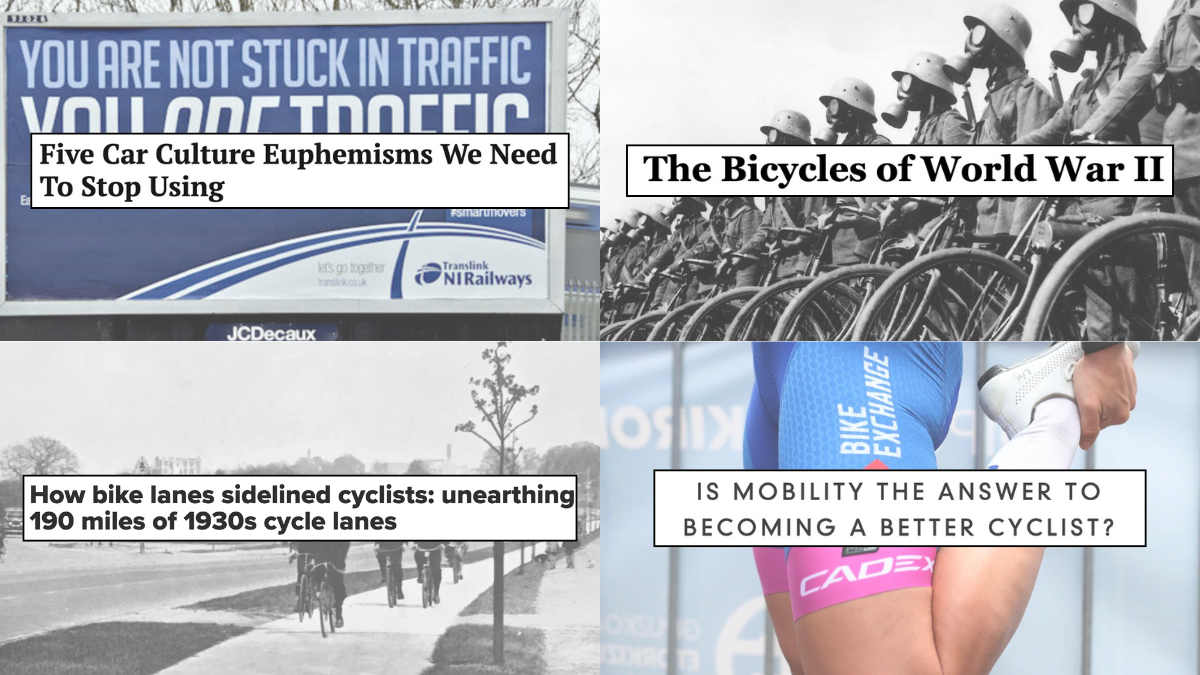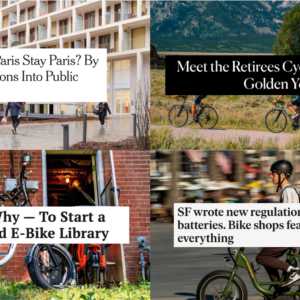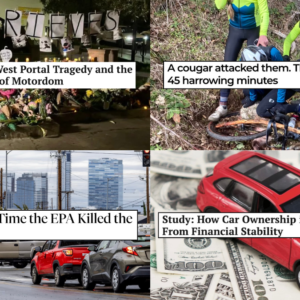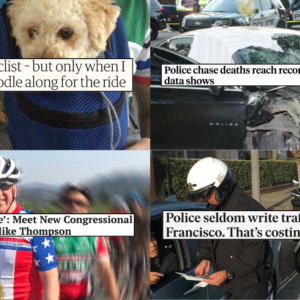Happy Monday everyone. I’m still in southern Oregon at a hospital (day 11!) while my dad recovers from a few surgeries and other issues. Should be home any day now and am able to do a bit more work now that he’s on the other side of this emergency. Can’t wait to get home and out onto the streets… might even be at Bike Happy Hour this week which would be so nice.
Here are the top stories our community has come across in the past seven days…
But first… If you’re looking to get away and do something really fun, check out the Cannon Beach Fat Bike Festival, May 17-19th. Now, on with the roundup…
All riders welcome: If organizers truly want to make their events “inclusive” they should consider financial aid for entry fees, more sizes for event swag, longer hours for aid stations and more, says “All Bodies” advocate Marley Blonsky. (Cycling Weekly)
Car culture euphemisms: America’s dysfunctional allegiance to the automobile is hidden in many words and phrases most people use without even thinking twice. (Streetsblog USA)
Potholes and funding holes: This excellent deep dive explains why Portland has fallen so far behind in road maintenance and what we really need to get out of it (not just more money, but a new way to collect it.) (Willamette Week)
Not ambitious enough: “I don’t think we’re being honest with ourselves about how little progress we’re making on greenhouse gasses and climate,” said persistent critic Joe Cortright in this Earth Day article about Portland transportation. (The Oregonian)
War machines: A remarkable set of images that illustrates the diverse utility of bicycles used during World War II. (The Atlantic)
Better bike parking: Leading supplier of urban bike parking solutions, Oonee, has signed its first contract outside of the New York/New Jersey area with a major contract for secure bike parking pods to be installed in Minneapolis. (Oonee)
Final stages: Indoor riding and power meter brand Stages Cycling, which has several employees in a Portland office, appears to have shut down. (Bicycle Retailer & Industry News)
Stretched thin: If you don’t spend time on flexibility as part of your cycling routine, you will never reach your comfort and performance potential on the bike. (Roleur)
Class dynamics: UK transportation journalist Carlton Reid’s amazing history project has helped reveal not just long-forgotten cycle tracks, but the classism that forced bike riders off the roads and led to the car-centric cities we suffer from one century later. (Global Cycling Network)
Thanks to everyone who sent in links this week. The Monday Roundup is a community effort, so please feel free to send us any great stories you come across.








Thanks for reading.
BikePortland has served this community with independent community journalism since 2005. We rely on subscriptions from readers like you to survive. Your financial support is vital in keeping this valuable resource alive and well.
Please subscribe today to strengthen and expand our work.
In regards to Bicycles of WW2:
That article and similar pictures should be must read knowledge in PPS. Imagine if children could see how relentlessly practical and hardcore bicycle transportation was and can be again. Those soldiers were wearing and carrying everything they had in the world while navigating mud, rock, ice, etc and expected to engage in combat at a moment’s notice. I’m a little embarrassed thinking how I check and recheck my weather app while planning and preparing my riding outfit.
Bicycles are incredible and kids need to grow up knowing and internalizing that they are a legitimate way to get around.
Picture #18 is an epic cruiser (anyone know the brand??) and #31 heartrending (well, they all are, but that one somehow just hits hard).
Some more pics of the Japanese invasion of Malaya (Peninsular Malaysia) as the Japanese are “following the concept of wiping out the Western colonialism from the region.” and unfortunately replacing it with Japanese colonialism.
“When enemies were pursued, punctured tires of Japanese bikes were simply taken off in a hurry and the bicycles were ridden on their bare rims. The sound of forthcoming peloton made a noise resembling that of the tanks turning the Allied forces in uncoordinated flee with the panic and outcries saying, “Here come the tanks!””
Anybody want to try that at next years Ladds 500?
https://www.welovecycling.com/wide/2019/06/28/japanese-style-bicycle-blitzkrieg/
Well Jake, you sent me back to Churchill, The Hinge of Fate. The most chilling reading in the six volumes of his World War II was, for me, his description of losing Singapore:
Moreover, it had never entered into my head that no circle of detached forts of a permanent character protected the rear of the famous fortress. I cannot understand how it was that I did not know this…
I do not write this in anyway to excuse myself. I ought to have known. My advisers ought to have known and I ought to have been told, and I ought to have asked. The reason I had not asked about this matter, amid the thousands of questions I put, was that the possibility of Singapore having no landward defenses no more entered my mind than that of a battleship being launched without a bottom.
‘… the whole island must be fought for until every single unit and every single strong point has been separately destroyed. Finally, the city of Singapore must be converted into a citadel and defended to the death …’
The Japanese did it with bicycles, huh?
A few Japanese units got from Point A to Point B slightly faster than if they had walked.
Not all soldiers had bikes.
So no, they didn’t conquer Singapore with bikes, they were a tiny fraction of the whole Japanese army.
Without the overland push it would not have been anywhere near as successful as it was with the bicycles. Bicycles are incredible and their worth was shown to the world, the modern world has just forgotten. Oregon National Guard did an exercise in Singapore and I was amazed at how much it would have taken to have fought a gasoline dependent war in those conditions. I would have rather had a bicycle as well.
Influenced by the intense heat and impassable jungle, Japanese planners decided from the beginning to use bicycles rather than horses as a means of troop and light material transportation. This decision allowed the foot soldiers to travel farther, faster, and with less fatigue. Due to the vast number of rivers on the Malay peninsula, and the British propensity to destroy the more than 250 bridges they crossed during their retreat, bicycles allowed the infantry (to continue) their advance, wading across the rivers carrying their bicycles on their shoulders, or crossing on log bridges held up on the shoulders of engineers standing in the stream.13
The British could not escape the troops on bicycles. They were overtaken, driven off the paved roads into the jungle, and forced to surrender.
https://www.ibiblio.org/hyperwar/PTO/RisingSun/BicycleBlitz/
In its 1937 invasion of China, Japan employed some 50,000 bicycle troops. Early in World War II their southern campaign through Malaya en route to capturing Singapore in 1941 was largely dependent on bicycle-riding soldiers. In both efforts bicycles allowed quiet and flexible transport of thousands of troops who were then able to surprise and confuse the defenders. Bicycles also made few demands on the Japanese war machine, needing neither trucks nor ships to transport them, nor precious petroleum.
https://en.wikipedia.org/wiki/Bicycle_infantry
Looking at the photos, it’s an interesting contrast between the beginning of the war when everyone is young and fresh, and the end when all the younger German men are dead already and the male soldiers are either very young or very old, and the women are obviously hungry. I do think about the post-war movies made about WW2, that in Das Boot there must have been a secret stash of personal bicycles on board, and it’s pretty easy to imagine a Sherman tank in Kelly’s Heros having a bike or two strapped on the back, but naturally that would have been too much for auto-oriented Hollywood.
The pic where the german woman is holding onto her bicycle against the soviet soldier is incredible! The desperation shown to hang onto what was clearly an item precious enough to resist conquerors who had few qualms against imprisoning or shooting civilians is amazing.
Kelly’s Heros is really one of the better tank movies and does a good job with fire commands and the way in which the tanks were horribly inaccurate when moving so would come to a halt to fight. I never thought about them having bicycles, but you’re right, they probably would have in real life.
I don’t know what to make of the fact that the banner sponsor of We Love Cycling is car manufacturer Skoda.
Clicking on “About Us” reveals that WeLoveCycling.com is actually a product of Skoda and any personal data the website acquires goes directly to Skoda Auto.
Wow… that’s even worse than I imagined. I didn’t happen to read their About page, but I did read on Wikipedia that Skoda is a subsidiary of VW (of emissions test-fraud infamy).
sorry folks. That link has been deleted.
Skoda sponsors a lot of cycling races in Europe (and also manufactures more than just cars – they built some of the streetcars here in Portland too). They are the title sponsor for the Green Jersey in the Tour de France as well. Given that the site seems to be mostly about the European pro cycling circuit, I don’t think this is very surprising though agree it mostly looks like just a pro-Skoda industry page.
Potholes are great for traffic calming in my neighborhood.
Seriously, when I see them forming in intersections, I’m glad for the free traffic calming. Usually the last thing I’d want to do is call them in!
But, I’d rather just have smooth asphalt on bike routes and diverters instead of potholes.
From the WW article on road maintenance:
Is there any particular reason the City Council couldn’t ask Portland voters to earmark 50% of utility license fees for road repairs and improvements? Yeah, it impacts the general fund which is something the City Council would need to deal with (personally, I’d let the police budget take the hit), but seems more likely to me to win voter support than a new tax, like a vehicle miles travelled tax or a street fee.
Utilities in urban areas seem to be under the streets, and unless the street is built with utility vaults and passages that means cutting the pavement, digging it up, putting in conduits of some sort, and then filling and patching the street.
Portland downtown streets were cut up at least twice to install optical fiber for data transmission.
Often the repairs are inadequate and this impacts bike riders more than anyone. Uneven pavement is dangerous and uncomfortable whether you hit it square or at a narrow angle.
The voters shouldn’t have to weigh in on this. The City Council can allocate those fees as they see fit. They’re choosing not to put them towards infrastructure. That said, using the whole pot of ULFs for infrastructure would be a good move, but probably not sufficient. They total $86 million/year. A real chunk of change, but probably not enough on their own to fill our infrastructure back-log in a timely manner.
The main reason for voters to weigh in would be to pass a charter amendment to lock it in. If the City Council was willing to spend the money that way, they’d have done it long ago.
It’s quite clear that City Council is unwilling to pay for boring stuff like basic road maintenance when so many other bright shiny objects keep grabbing their attention. The only way to keep our roads maintained is a dedicated funding stream that the Council can’t raid.
I hit a pothole and broke my arm while riding to work on SE 17th, a week and a half ago. The irony is that I’ve been riding SE 17th because the pavement on SE 19th is comparatively worse.
I’m not able to work for a month while the bone heals. This is one cost of poor maintenance, as born by an individual citizen.
I would be very happy to see the City maintain the bike streets with the urgency befitting their importance to local transportation. We will never get to 25% mode share if we allow obstacles to dis-incentivize riding.
That’s too bad, heal well.
Thank you! I’m lucky to have good medical care.
The Gen Z article confounds me. It is one thing to compare trends, but another to say that Gen Z prefers such and such over Millennials. You have to control for what Millennials were doing at the same age. A lot of the findings can be explained away by typical changes in life priorities. Another problem is that the people who use Strava are not a representative sample.
The political lift is “huge” because the math is insane if the goal is to approach anything near the $4.4B in maintenance backlog, which should probably be the baseline goal.
Under the current funding scheme, if a “typical” 12,000 mile driver with a 20 MPG car fills up entirely in Portland, the revenue is $60 in gas tax per year or about half a cent per mile.
Assuming under VMT taxation the goal is to get to $4.4B and they manage to get people on board with $0.05 per mile, which as reasonable as that sounds on the surface, is 10x the current amount per mile with very generous assumptions, Portland needs vehicles to travel 88 Billion miles. If there are 500,000 registered cars in Portland (lol at the thought of Portland issuing 500k trackers) that means we need 176,000 miles per driver or about 15 years of people driving 12k miles per year ONLY in Portland.
What’s worse, the above doesn’t contemplate anything to do with inflation. If the Fed can turn off the printers for a few minutes and we actually get inflation back to 2%, and they enact this plan, which would generate $300MM in annual revenue which is a huge step, but the backlog would also go up by almost $90MM, so almost a third of the revenue is being eaten up by inflation on the backlog balance. This is with a 10x increase on the gas tax per mile too, if they can only get 2 cents per mile, that would basically have us treading water at $120MM per year in revenue, but $90MM being eaten up by inflation of the backlog balance, so in real terms you’re getting $30MM in work done, which is to say, not much.
Of course, this assumes the entirety will be paid by regular cars and doesn’t contemplate commercial vehicles, but any additional tax to those vehicles will just be passed to the consumer anyway, so what’s the point.
It looks like the best case scenario is the big one hits, destroys all of the infrastructure and Uncle Sam cuts a check for $20B for us to rebuild with a bunch of shiny new things, because there is no fiscal way we’re solving this ourselves unless I am completely naive to the residents of Portland looking for another $600 annual bill.
I really is quite astounding how much it actually costs to build an maintain the infrastructure necessary for nearly everyone to make nearly all of their trips in single occupancy vehicles.
It seems unlikely that we pass a VMTax that will cover the costs and probably unlikely that the federal gov’t cuts a check to pay for it either. But where does that leave us? What will our streets look like in 10 years if we still aren’t doing all of the maintenance we need to do now to prevent more expensive repairs in the future?